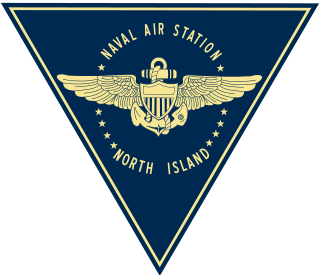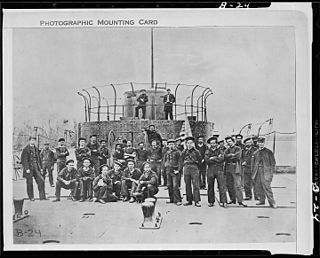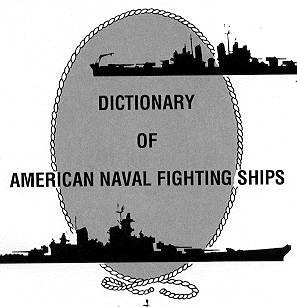
USS Indianapolis (CL/CA-35) was a Portland-class heavy cruiser of the United States Navy, named for the city of Indianapolis, Indiana. Launched in 1931, the vessel served as the flagship for the commander of Scouting Force 1 for eight years, then as flagship for Admiral Raymond Spruance in 1943 and 1944 while he commanded the Fifth Fleet in battles across the Central Pacific during World War II.

The Mare Island Naval Shipyard (MINSY) was the first United States Navy base established on the Pacific Ocean. It is located 25 miles northeast of San Francisco in Vallejo, California. The Napa River goes through the Mare Island Strait and separates the peninsula shipyard from the main portion of the city of Vallejo. MINSY made a name for itself as the premier US West Coast submarine port as well as serving as the controlling force in San Francisco Bay Area shipbuilding efforts during World War II. The base closed in 1996 and has gone through several redevelopment phases. It was registered as a California Historical Landmark in 1960, and parts of it were declared a National Historic Landmark District in 1975.

Eastport is a small city in Washington County, Maine, United States. The population was 1,331 at the 2010 census, making Eastport the least-populous city in Maine. The principal island is Moose Island, which is connected to the mainland by causeway. Eastport is the easternmost city in the United States.

The United States Pacific Fleet (USPACFLT) is a Pacific Ocean theater-level component command of the United States Navy that provides naval forces to the United States Indo-Pacific Command. Fleet headquarters is at Pearl Harbor Naval Station, Hawaii, with large secondary facilities at North Island, San Diego Bay on the Mainland.

USS Nimitz (CVN-68) is a supercarrier of the United States Navy, and the lead ship of her class. One of the largest warships in the world, she was laid down, launched and commissioned as CVAN-68; "aircraft carrier, attack, nuclear powered", but she was later redesignated as CVN-68; "aircraft carrier, multi-mission", nuclear-powered", on 30 June 1975, as part of a fleet-wide realignment that year.

USS Alabama (BB-60), a South Dakota-class battleship, was the sixth ship of the United States Navy named after the US state of Alabama. Alabama was commissioned in 1942 and served in World War II in the Atlantic and Pacific theaters. Alabama was decommissioned on 9 January 1947 and placed in the reserve fleet in Puget Sound Naval Shipyard Bremerton, Washington. In 1964, Alabama was towed to Mobile Bay and opened as a museum ship the following year. The ship was added to the National Historic Landmark registry in 1986.

Ulithi is an atoll in the Caroline Islands of the western Pacific Ocean, about 191 km (103 nmi) east of Yap. It consists of 40 islets totalling 4.5 km2 (1.7 sq mi), surrounding a lagoon about 36 km (22 mi) long and up to 24 km (15 mi) wide—at 548 km2 (212 sq mi) one of the largest in the world. It is administered by the state of Yap in the Federated States of Micronesia. Ulithi's population was 773 in 2000. There are four inhabited islands on Ulithi Atoll. They are Falalop, Asor (Yasor), Mogmog (Mwagmwog), and Fedarai (Fedraey). Falalop is the most accessible with an air strip, a small resort hotel, gas dealership, store and one of three public high schools in Yap state. Mogmog is the seat of the high chief of Ulithi Atoll though each island has its own chief. Other important islands are Losiap, Sorlen (Sohl'oay), and Potangeras (Potoangroas).

USS Enterprise (CV-6) was the seventh U.S. Navy vessel to bear the name. Colloquially called "The Big E", she was the sixth aircraft carrier of the United States Navy. A Yorktown-class carrier, she was launched in 1936 and was one of only three American carriers commissioned before World War II to survive the war. She participated in more major actions of the war against Japan than any other United States ship. These actions included the Attack on Pearl Harbor, the Battle of Midway, the Battle of the Eastern Solomons, the Battle of the Santa Cruz Islands, various other air-sea engagements during the Guadalcanal Campaign, the Battle of the Philippine Sea, and the Battle of Leyte Gulf. Enterprise earned 20 battle stars, the most for any U.S. warship in World War II, and was the most decorated U.S. ship of World War II. She is also the first American ship to sink an enemy warship during the Pacific War when she sank Japanese submarine I-70 on 10 December 1941. On three occasions during the Pacific War, the Japanese announced that she had been sunk in battle, inspiring her nickname "The Grey Ghost".

USS Nautilus (SSN-571) was the world's first operational nuclear-powered submarine and the first submarine to complete a submerged transit of the North Pole on 3 August 1958.

The United States Third Fleet is one of the numbered fleets in the United States Navy. Third Fleet's area of responsibility includes approximately fifty million square miles of the eastern and northern Pacific ocean areas including the Bering Sea, Alaska, the Aleutian Islands and a sector of the Arctic. Major oil and trade sea lines of communication within this area are critically important to the economic health of the United States and friendly nations throughout the Pacific Rim region.
New York most commonly refers to:

Operation Highjump, officially titled The United States Navy Antarctic Developments Program, 1946–1947, was a United States Navy operation organized by Rear Admiral Richard E. Byrd, Jr., USN (Ret), Officer in Charge, Task Force 68, and led by Rear Admiral Richard H. Cruzen, USN, Commanding Officer, Task Force 68. Operation Highjump commenced 26 August 1946 and ended in late February 1947. Task Force 68 included 4,700 men, 13 ships, and 33 aircraft. Operation Highjump's primary mission was to establish the Antarctic research base Little America IV.

Naval Air Station North Island or NAS North Island is located at the north end of the Coronado peninsula on San Diego Bay and is the home port of several aircraft carriers of the United States Navy. It is part of the largest aerospace-industrial complex in the United States Navy—Naval Base Coronado (NBC) in San Diego County, California.
Tortuga is the Spanish word for a turtle or tortoise. It may also refer to:

The first USS Lehigh was a Passaic-class monitor launched 17 January 1863 by Reaney, Son & Archbold, Chester, Pennsylvania, under a subcontract from John Ericsson; and commissioned at Philadelphia Navy Yard 15 April 1863, Commander John Guest in command.

The second USS Ardent (AM-340) was a Auk-class minesweeper in the United States Navy.
USS Penobscot (ATA-188/ATR–115) -- a Sotoyomo-class auxiliary fleet tug—was originally placed in service by the U.S. Navy as USS ATA–188 until she was renamed USS Penobscot (ATA-188) 16 July 1948. She served in the Pacific Ocean during World War II, and on the U.S. East Coast after the war’s end. She was finally decommissioned in 1971.

Project Hula was a program during World War II in which the United States transferred naval vessels to the Soviet Union in anticipation of the Soviets eventually joining the war against Japan, specifically in preparation for planned Soviet invasions of southern Sakhalin and the Kuril islands. Based at Cold Bay in the Territory of Alaska, the project was active during the spring and summer of 1945. It was the largest and most ambitious transfer program of World War II.
















